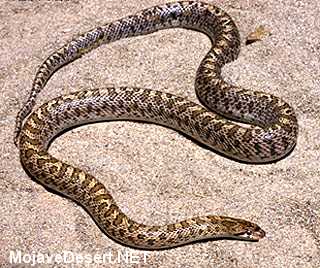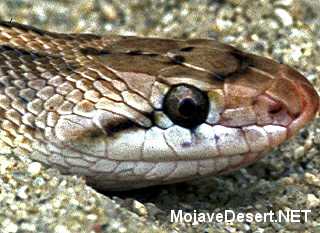Glossy Snake
Arizona elegansFamily: Colubridae Order: Squamata Class: Reptilia
DISTRIBUTION, ABUNDANCE, AND SEASONALITY
This snake is common throughout southern California especially in desert regions. Less
common to the north, glossy snakes occur in the interior Coast Ranges as far as Mount
Diablo in Contra Costa Co. Glossy snakes are most common in desert habitats but also
occur in chaparral, sagebrush, valley-foothill hardwood, pine-juniper, and annual grass.
Elevation from below sea level to 1830 m (6,000 ft).
SPECIFIC HABITAT REQUIREMENTS
Feeding: Glossy snakes feed on a variety of desert lizards including juvenile desert
iguanas (Cunningham 1959), and zebra-tailed lizards (Vitt and Ohmart 1977). They are listed
as probable predators of side-blotched lizards by Ferguson et al. (1982). Captive individuals
have been observed to eat young mice and small birds (Stebbins 1954).
Cover: Primarily nocturnal, glossy snakes spend periods of inactivity during the day and
during winter in mammal burrows and rock outcrops, and to a lesser extent under surface
objects such as flat rocks and vegetation residue. Individuals occasionally burrow in loose
soil.
Reproduction: Eggs are laid a few centimeters below the surface in loose soil, under
surface objects or near the base of vegetation, or in abandoned mammal burrows.
Water: No information on water requirements. Glossy snakes are most common in arid
regions. Standing water is not an important habitat element.
Pattern: Prefer open sandy areas with scattered brush, but also found in rocky areas.
SPECIES LIFE HISTORY
Activity Patterns: Although some diurnal activity has been reported, glossy snakes are
most active at night. Individuals are most commonly encountered in May and June in the
south. In the interior Coast Ranges another activity peak occurs prior to the first rains of fall.
Periods of winter inactivity occur at all localities.
Seasonal Movements/Migration: Predictable seasonal movements have not been reported
for this species in California.
Home Range: The nature of the home range in this species is unknown.
Territory: No evidence for the territorial defense of resources has been reported.
Reproduction: Eggs are probably laid in early July. Clutch sizes range from 3 to 23 (mean
8 or 9). Hatching occurs from late August to mid-September (Stebbins 1954, Aldridge 1979).
Mating probably occurs in the spring soon after the end of the period of winter inactivity.
Niche: Glossy snakes may be taken by mammals, owls, and other snakes. The nature of
competitive interactions with other species of snakes is unknown. The diet of glossy snakes
overlaps to some extent with that of several species of desert snakes.
Also see:
Joshua Tree National Park Wildlife
Mojave Glossy Snake Arizona occidentalis candida Prefers sandy areas, but also occurs on hard pan or in rocky areas; northern section (common) ...
Death Valley Snakes
Desert Patch-nosed Snake Salvadora hexalepis hexalepis Rocky and sandy areas from lower slopes and washes up to 6000 feet. Desert Glossy Snake ...
Death Valley Wildlife
Males are glossy-black with long tails; the brown females have shorter tails. ... Sidewinder (snake) The rattlesnakes are found mainly in lower elevations. ...

Glossy Snake
Photo by Chris Brown

Glossy Snake
Photo by Chris Brown

Glossy Snake
Photo by Chris Brown
Additional information:
Scientific name: Arizona elegans occidentalis
Common name: California Glossy Snake
Size: 25.2-38.9 in (64-99 cm)
Distinguishing characters: Smooth, glossy scales; chocolate colored body blotches on a tan or light brown ground color; prominent eye stripe; eyes with slightly vertical pupils; countersunk lower jaw; single anal scale.
Juveniles: Similar to adults, but blotches darker.
Dimorphism: None
Similar species: Pituophis melanoleucas: Has keeled scales; eyes with round pupils; divided anal scale. Hypsiglena torquata: Has a triangular flattened head; vertical pupils; white labial scales.
Additional notes: An uncommon species in focal area, although historically this subspecies was widespread. Primarily nocturnal, it is associated with loose soils in valleys and washes suitable for burrowing. Gentle, calm, and easily handled. This appears to be a species currently in great decline. Surveys for suitable habitat should be conducted and sightings of this species should be verified and recorded.